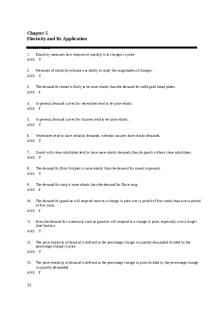5 C Invento - 5 C Framework PDF

| Title | 5 C Invento - 5 C Framework |
|---|---|
| Author | Aashna Duggal |
| Course | Global Marketing Management |
| Institution | Universal Business School |
| Pages | 2 |
| File Size | 31.3 KB |
| File Type | |
| Total Downloads | 73 |
| Total Views | 149 |
Summary
5 C Framework...
Description
5 C’s of marketing 1. COMPANY - Invento was started by Balaji Viswanathan in Bangalore in 2016 with the aim to make robots, specifically humanoid robots, relevant in the households of India. Invento designed and manufactured two product lines, named Mitra and Mitri, humanoid robots in male and female versions. Invento’s mission was to productize key inventions from the labs by combining research with business sense. Unique features like locationbased awareness, gesture-based immersive voice conversations and ability to detect emotions, objects and faces, focusing on enterprise applications gave it a competitive advantage. 2. COLLABORATORS - Invento had built a vendor supply chain to outsource many of the standardized components required in the assembly of robots. However, company lacked direct distribution partners and majority of its sales were driven through its own sales professionals. Small and medium-sized enterprises often lacked the resources and the right sales force to sell a complex product such as the Mitra and Mitri robots. The company was deliberating upon having an external sales agency that could present new opportunities as a channel partner and drive up sales.
3. CUSTOMERS – Invento targeted Fortune 1000 companies that required humanoid robots. Its primary customers mainly belonged to two industries namely banking, finance, and insurance (BFI); and IT. Some prominent names included Barclays PLC, HDFC Bank Limited, Accenture PLC, Infosys Limited, and HCL Technologies. In general, Invento positioned its humanoids for six major industries and sectors: retail, finance, health care, government, hospitality, and education. In addition to industry requirements, Invento categorized its customers into two groups called vanity, which catered to high-end customers and sanity segment who had a complex and long-buying process. 4. COMPETITORS - As of 2017, China was the biggest market, closely followed by Japan and Germany. However, new markets such as Mexico, India, and Australia had displayed faster growth rates. Major international players included Japan-based SoftBank Robotics and China-based Amy Robotics and Sanbot Robotics (Sanbot) from China. SoftBank was Invento’s major competition and Pepper, a robot built by Aldebaran, a French robotics company later acquired by SoftBank Robotics, was possibly most similar to Invento’s offerings. Sanbot was also a Chinese robotics firm and had four major humanoid offerings, differentiated by size: Sanbot Nano, Sanbot Elf, Sanbot Mini Elf, and Sanbot Max. Apart from international competitions, Invento’s robots faced competition from Indian manufacturers such as Sirena Technologies. 5. CONTEXT - According to an industry profile on global robots published by MarketLine, all strategic forces namely buyer power, supplier power, degree of rivalry, threat of substitutes, and threat of new entrants were equally high and played a relatively important role in the industry. Extensive specialization in production resulted in high switching costs. To understand the legal aspect, entry to market was restricted due to
the intellectual property rights held by existing players. However, new players were quickly emerging and were applying their knowledge to new developments and proprietary technology. The use of humanoids was an increasing trend globally, with an expected compound annual growth rate (CAGR) of 35 per cent from 2017 to 2024....
Similar Free PDFs

5 C Invento - 5 C Framework
- 2 Pages

Föreläsning 5, C#
- 5 Pages

EBOOK BAHASA C 5
- 13 Pages

AD594 5 c - Lecture notes 5
- 8 Pages

5. El sistema Fe-C - Apunts 5
- 16 Pages

Task 5 Deliverable Template C
- 2 Pages

Unidad 5 Introduccion a C++
- 13 Pages

Chapter 5 - M/C with answers
- 79 Pages

LAS 5 C´S DE Equipo
- 1 Pages

Taelln 801 C Storm Activity 5
- 12 Pages

Ficha DE Análisis Pintura C-5
- 1 Pages
Popular Institutions
- Tinajero National High School - Annex
- Politeknik Caltex Riau
- Yokohama City University
- SGT University
- University of Al-Qadisiyah
- Divine Word College of Vigan
- Techniek College Rotterdam
- Universidade de Santiago
- Universiti Teknologi MARA Cawangan Johor Kampus Pasir Gudang
- Poltekkes Kemenkes Yogyakarta
- Baguio City National High School
- Colegio san marcos
- preparatoria uno
- Centro de Bachillerato Tecnológico Industrial y de Servicios No. 107
- Dalian Maritime University
- Quang Trung Secondary School
- Colegio Tecnológico en Informática
- Corporación Regional de Educación Superior
- Grupo CEDVA
- Dar Al Uloom University
- Centro de Estudios Preuniversitarios de la Universidad Nacional de Ingeniería
- 上智大学
- Aakash International School, Nuna Majara
- San Felipe Neri Catholic School
- Kang Chiao International School - New Taipei City
- Misamis Occidental National High School
- Institución Educativa Escuela Normal Juan Ladrilleros
- Kolehiyo ng Pantukan
- Batanes State College
- Instituto Continental
- Sekolah Menengah Kejuruan Kesehatan Kaltara (Tarakan)
- Colegio de La Inmaculada Concepcion - Cebu




